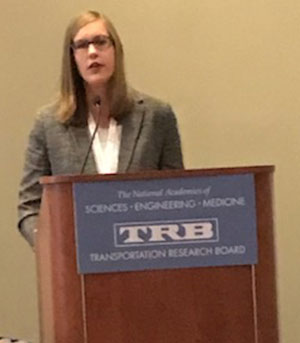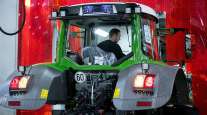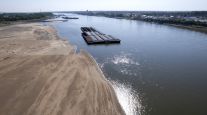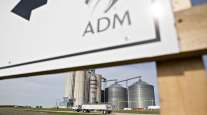Ag Industry, Ports Adjusting to Fast-Changing Landscape
WASHINGTON — The agricultural industry and the ports that serve it are simultaneously working to respond to an evolving business landscape that includes everything from making room at East Coast ports for Neopanamax containerships to serving overseas demand for fresh fish, industry experts said here.

Struxness speaks at TRB. (Joe Howard/Transport Topics)
The arrival of these mammoth ships to the East Coast, brought about by the recent Panama Canal expansion of its locks, has compelled the ports to make improvements.
“The ports and the terminals are working hard to keep infrastructure up to date for these big ships,” said Abigail Struxness, program director for the Agriculture Transportation Coalition, during a session at the Transportation Research Board annual meeting focused on multimodal opportunities for emerging challenges in moving food around the world.
“There truly is a race going on up and down the East Coast to go to 50 feet,” said Chris Gullickson, economic development manager for the Port of Virginia, referring to the depth required for marine ports to accept Neopanamax vessels.
The Virginia Port Authority, which operates as the Port of Virginia, runs six terminals in the state, two of which — Norfolk International Terminal and Virginia International Gateway — already are 50 feet deep and have approval from Congress to dredge to 55 feet, Gullickson said.
And as the state’s ports grow, trucks are handling most of the cargo, he said.
There truly is a race going on up and down the East Coast to [dredge] to 50 feet.
Chris Gullickson, Port of Virginia
“Truck is king,” he said, adding that 60.7% of the Virginia ports’ traffic last year was handled by truck while 36.3% was handled via rail. For fiscal year 2017, the Virginia ports posted a 7.2% growth rate over fiscal 2016, he said.
Though busier ports are good for fleets’ businesses, they can also lead to more port congestion. With the Dec. 18 adoption of the Federal Motor Carrier Safety Administration’s electronic logging device mandate — which requires drivers to record their hours of service on the devices — concerns are growing about port delays as carriers adjust, Struxness said.
“If a driver is waiting in line to get into a terminal, what if [he] runs out of service and has to shut down his truck,” she said. “Some carriers say [the mandate] it helps manage dispatch, but smaller operators are really struggling to comply. There have been some fears of rate increases, but we haven’t seen that yet.”
Finding drayage drivers may also get more challenging, Struxness added. “Driver recruitment has been a troublesome issue for last several years. Folks would rather not deal with congestion at the ports,” she said.
But these challenges likely won’t slow cargo movements, and ports will be tasked with handling the growth — including strong demand from overseas customers.
“We produce more agricultural goods in the United States than we as a country can consume ourselves,” Struxness said, citing 83% of her group’s members export products to Korea, Japan or China — responding to a demand that in years passed simply didn’t exist.
“Change in appetites is a real driver,” said Charles Edwards, director of strategic planning for the North Carolina Department of Transportation. “In China, there was no demand for dairy in the 1980s. That has changed.”
Specialty items are also driving up demand and rates for air cargo, Edwards said, pointing specifically to Bing cherries. They are being harvested in Washington and sent straight to China and also fresh fish that can be packaged and shipped via commercial airliners overseas within days.
“Containers in the belly of a commercial airplane carrying perishable goods may haul a lot less than a containership, but the rates are much higher,” he said.





